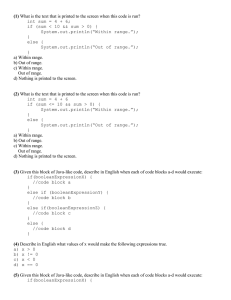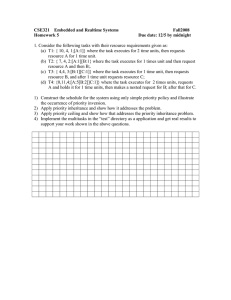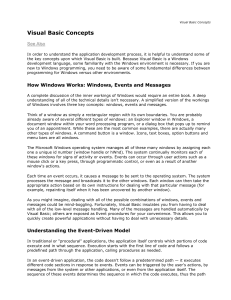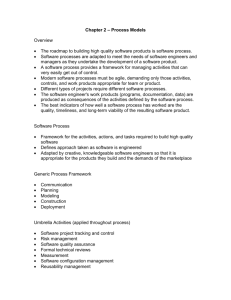(1) int sum = 4 + 6;
advertisement
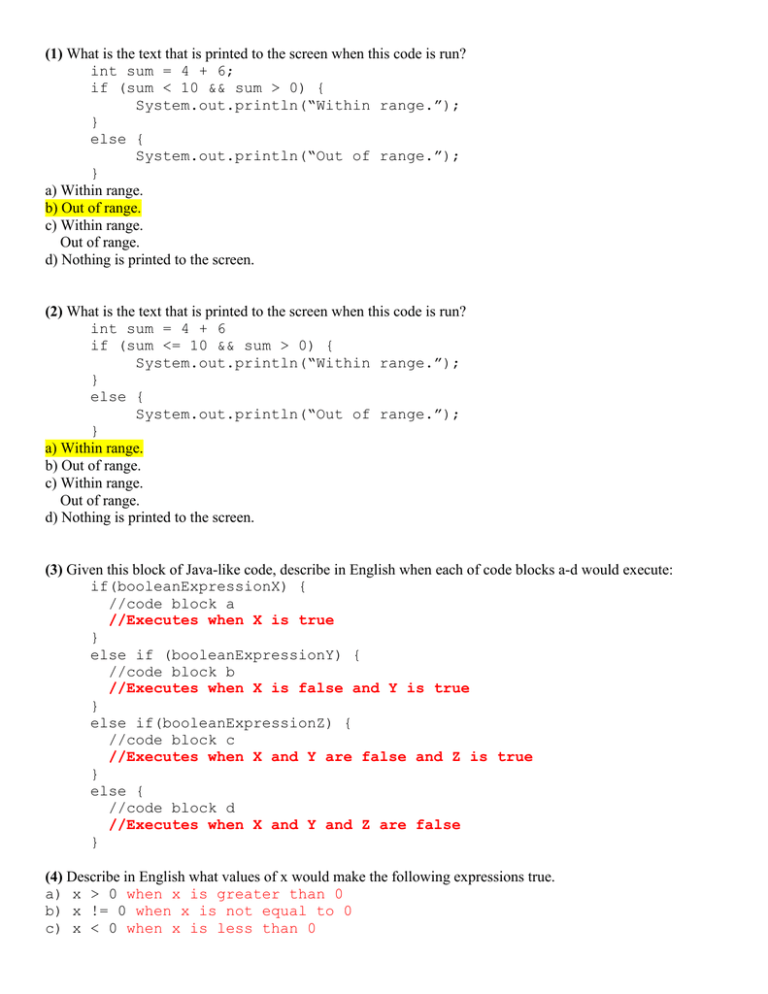
(1) What is the text that is printed to the screen when this code is run?
int sum = 4 + 6;
if (sum < 10 && sum > 0) {
System.out.println(“Within range.”);
}
else {
System.out.println(“Out of range.”);
}
a) Within range.
b) Out of range.
c) Within range.
Out of range.
d) Nothing is printed to the screen.
(2) What is the text that is printed to the screen when this code is run?
int sum = 4 + 6
if (sum <= 10 && sum > 0) {
System.out.println(“Within range.”);
}
else {
System.out.println(“Out of range.”);
}
a) Within range.
b) Out of range.
c) Within range.
Out of range.
d) Nothing is printed to the screen.
(3) Given this block of Java-like code, describe in English when each of code blocks a-d would execute:
if(booleanExpressionX) {
//code block a
//Executes when X is true
}
else if (booleanExpressionY) {
//code block b
//Executes when X is false and Y is true
}
else if(booleanExpressionZ) {
//code block c
//Executes when X and Y are false and Z is true
}
else {
//code block d
//Executes when X and Y and Z are false
}
(4) Describe in English what values of x would make the following expressions true.
a) x > 0 when x is greater than 0
b) x != 0 when x is not equal to 0
c) x < 0 when x is less than 0
d) x == 0 when x is equal to 0
(5) Given this block of Java-like code, describe in English when each of code blocks a-d would execute:
if(booleanExpressionX) {
//code block a
//Executes when X is true
}
else {
//code block b
//Executes when X is false
}
if(boolean ExpressionY) {
//code block c
//Executes when Y is true (the value of X does not matter)
if(booleanExpressionZ) {
//code block d
//Executes when Y is true and Z is true (X’s truth irrelevant)
}
}
(6) Given this block of Java-like code, describe in English when each of code blocks a-d would execute:
if(booleanExpressionX) {
//code block a
//Executes when X is true
}
if(booleanExpressionY) {
//code block b
//Executes when Y is true (X can either be true or false)
}
if(boolean ExpressionZ) {
//code block c
//Executes when Z is true (X and Y can either be true or false)
}
else {
//code block d
//Executes when Z is false (X and Y can either be true or false)
}
(7) Write the method definition for a method named myMethod that takes as a parameter a Ball and returns a
Shape object. You can leave the body of the method empty.
public Shape myMethod(Ball ball) {
}
(8) Write the method definition for a method named getSize that does not take any parameters, but does return a
Dimension object. You can leave the body of the method empty.
public Dimension getSize() {
}
(9) Write the method definition for a method named print16 that has a void return type and takes no parameters.
Inside the method, write a loop that would print out the numbers 1 to 16.
public void print16() {
for(int count = 1; count <= 16; count++) {
System.out.println(count);
}
}
(10) Use the following for-loop definition to answer parts a – d. Parts e & f do not use the same code.
for(int count = 1; count < 9; count++) {
System.out.println(count);
}
a)
b)
c)
d)
What is the initial value of this loop’s counter variable? 1
What is the value of this loop’s counter variable when the loop is done executing? 9
Circle the part of the code above that is considered the loop body.
How many times would this loop execute? 8
